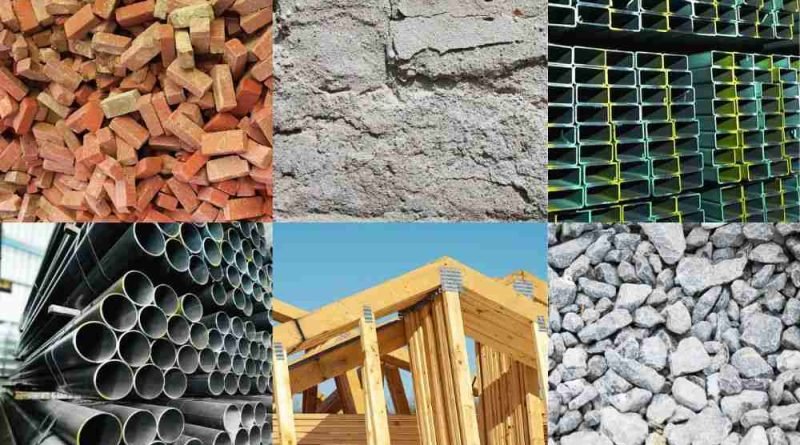Types of Building Materials Used in Construction
Building Construction is the process of adding structure to real property. Construction of buildings and infrastructures plays an important role in the development of countries. Construction starts with planning of building or infrastructure for construction, design of layout for construction and financing or costing require for construction.
In the world of construction, the building materials gives form and function to our architectural dreams. From the ancient mud bricks to the cutting-edge composites and technologies using in building construction, the array of building materials used in construction is vast and diverse.
Building Materials are the types of materials that are used in the construction of buildings. There is a wide variety of building materials used in construction, each with its unique properties and applications. The materials used for building construction purposes such as concrete, cement, stones, bricks, clay, metals, woods, aggregates, etc. are some of the most common type of building materials used in construction.
Read Also: Types of Buildings
The choice and selection of building materials used in construction are based on the applications, requirements of construction, types of structure and cost effectiveness for building projects. Here are some of the important types of building materials used for construction are as follows,
1. Concrete:
Concrete is the backbone of modern construction. Concrete is a composite building material made from the mixture of cement, water and combination of aggregate. It is renowned for its versatility, durability, and strength. From the construction of foundations and walls to the bridges and skyscrapers, concrete plays an important role in the modern construction as a material. Concrete has been the predominant material in this modern age due to its longevity, durability, strength, formability, and ease of transport.
2. Cement:
Cement is the primary component of concrete. Cement serves as a binding agent for construction materials. Cement is produced by burning a mixture of calcareous, siliceous, and aluminous raw materials at high temperatures and crushing the resulting clinkers into a fine powder. Cement is oldest and widely used construction material due to its physical properties such as strength, fineness, consistency, specific gravity, setting time and bulk density. Cement is used for constructing important structures like bridges, pipe culverts, dams, and tunnels.
3. Bricks:
Bricks are crafted from clay or shale, have a timeless appeal and hardened by heating or chemical process. Bricks are usually in rectangular shape used in traditional red or a range of colors, bricks are a staple for walls, pathways and facades. Bricks are formed by molding or a by commercial manufacture more frequently by extruding clay through a die and then wire-cutting into the proper size and shape. Nowadays, bricks are usually made from concrete, clay, fly ash, calcium silicate, lime, ceramics, etc. Bricks are used in constructions of buildings, masonry walls, paths, driveways, chimneys, fireplaces, etc.
4. Stone:
Stones are one of the oldest types of building materials used since ancient period times. Natural stones like granite, marble, stones, limestone, and sandstone have been used in building construction for centuries. Stones are used in construction mostly followed in areas that have availability of large number of stones. Stones provide strength and durability that making them ideal for both structural and decorative purposes.
5. Steel:
Steel is one of the most important material in modern building construction. Steel is a key material in modern construction. It is used in construction for structural frameworks, roofing, and reinforcement. Steel is widely used as structural framework for larger buildings such as skyscrapers, or as an external surface covering. Steel has high strength, functionality, easily available and convenient to ship from one place to another.
6. Glass:
Glass is also one of the widely used construction material in modern buildings. It is used for architectural appeal and also allow sunlight and insulation properties. Glass is made from liquid sand, silicates and is used in most buildings to construct facades and windows. The windows have been used since the invention of glass to cover small openings in a building.
7. Woods:
Woods are also one of the most widely used construction material since ancient time and centuries. It is naturally available and cost-efficient, strong and durable, and flexible keeping strength while bending, and is incredibly strong when compressed vertically. Wood has been a traditional building material for residential structures. Wood is a product that is easily available from trees and used for construction purposes when cut or pressed into lumber and timber.
8. Mud and Clay:
Mud and Clay is also one of the used materials used in building construction. The amount of each material used leads to different styles of buildings. The deciding factor is usually connected with the quality of the soil being used. Mud and clay are versatile materials, have been integral to building construction across diverse cultures.
9. Plastics:
Plastics are also one of the most important materials used for building construction. Plastics are widely used as pipes in construction. Plastic pipes penetrating a concrete floor in a high-rise apartment building. Plastics gives hardness, resiliency and vary immensely in heat tolerance. Plastics offer a high degree of design flexibility. Plastics are used in various interior elements, including decorative panels, flooring, and laminates.
For construction of building, the choice of building materials becomes a crucial factor in shaping sustainable, resilient, and visually appealing structures.




